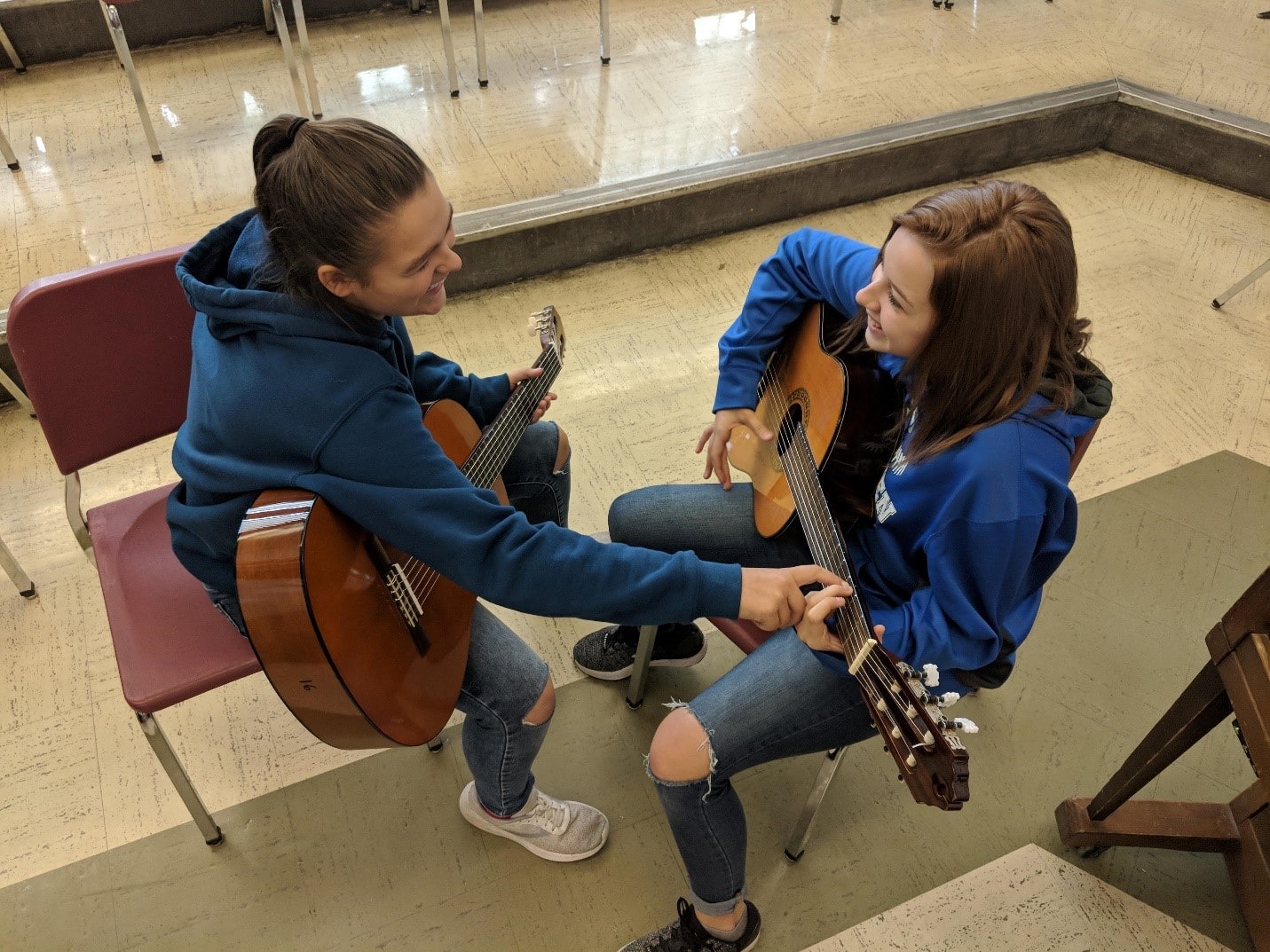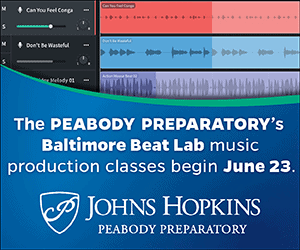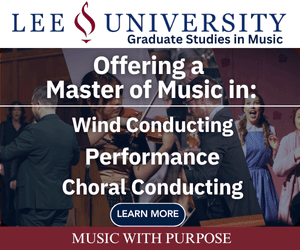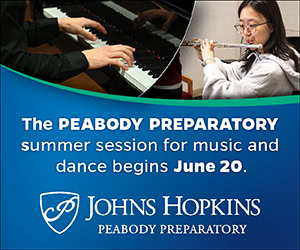/ News Posts / Guitar Class in the Keystone State
Guitar Class in the Keystone State
Number 15: The Commonwealth of Pennsylvania
By Thomas Amoriello Jr.
NAfME Council for Guitar Education Chair
Today we visit Saint Marys, located in Elk County, Pennsylvania. Originally a small town inhabited mostly by Bavarian Roman Catholics, it was founded December 8, 1842. It is home to Straub Brewery and the first Benedictine convent in the United States.

Photo courtesy of Adam Brooks
Saint Marys Area High School is built on modeling and reinforcing the values of RESPECT (treating others as you would like to be treated), HONOR (doing the right thing), and POTENTIAL (be all you can be in all that you do). Music educator Adam Brooks, a NAfME member, is a part of fostering that well-rounded education which includes the arts as well as being inclusive of guitar activities for students at Saint Marys. He is a firm believer in creating opportunities for students that they can enjoy. Each year, he strives to come up with fun, new ideas for the music department. At Saint Marys Area High School Adam is the Choral Director and teaches guitar, piano, and music electives. He thoroughly enjoys the great amount of fun they have in the music department and wishes that all students could have the opportunity to take a music class.
Mr. Brooks graduated from Bradford Area High School in 2002 and then attended Mansfield University, earning a Bachelor of Education in Music Education with elective studies in jazz in 2006 leads the guitar program. Throughout high school and college, he was in the marching band, chorus, musicals, wind ensemble, orchestra—basically any musical ensemble he could be in. He later attained a Master of Arts in Music Education from Mansfield University in 2015. Professionally, he has taught in three school districts: Punxsutawney, Cameron County, and Saint Marys, and this is his 13th year teaching students in K-6 and 9-12.
He enjoys playing soccer, tennis, mountain biking, and running and lives in Saint Marys, Pennsylvania, with his wonderful wife, Michelle, and three children, Ela, Alison, and Jamie. Adam Brooks loves to play and sing!
Please tell us about your school and overall music program.
The high school is made up of about 650+ students in grades 9-12. We have many specialized curricula where students may find their niche or prepare for the next educational chapter in their life such as CNA, EMT, and health programs and CTE courses that help students prepare for machining, powdered metal working, drafting, construction, and wood-working. We also have many AP and STEM courses where college-bound students find success. Our music program is made up of a wide range of students from all of these different school programs. On any given day, we will see about 125 students enter our classes for band, chorus, guitar, special education, piano, theory, appreciation, and an upper-level music lab. We also have extra-curricular ensembles such as marching band, indoor color guard, and indoor dance, as well as drama productions and musicals.
Please tell us about your own personal musical background growing up and your collegiate experience.
I have been around music all of my life growing up with a barbershop-singing father, a church bell choir mother, two pianos in the house, and older brothers who both played instruments while I was young. By 8th grade, I knew that I wanted to go to college for music education to become a teacher like some of my previous fantastic teachers. (Thank you, Mrs. Liebrum!) At Mansfield University, I majored in trumpet, but also loved to sing in the Festival Choir and Men’s Choir. I loved the one-on-one instruction with most of the professors and had the opportunity to learn many different teaching styles, all with one common goal: give all students a chance at great musical opportunities.

Photo courtesy of Adam Brooks
How do the guitar family instruments fit into your teaching?
Even though my parents bought me a guitar as a high school graduation gift, I never really took to it in college or after I graduated. It wasn’t until four years into teaching, when two students wanted to start a guitar class at the high school, that I actually gave it a fair shot. My principal allowed me to give them private “independent study” lessons for a semester. From then, I have taught about 20 sections of Guitar 1, an additional three sections of Guitar 2, and started a ukulele club this year. I also like to incorporate the guitar in choral songs and even in piano class to play an accompaniment to their songs. Sometimes it accounts for 50% of my teaching schedule! It has been a blast to learn with the students, and I have led many elementary classes in our town.
What obstacles did you face when you were first hired at your school? Now?
Luckily, I had three years of teaching experience before I entered my current school. During that time, I had the chance to work out the “bugs” in my teaching style as well as my communication skills and interpersonal skills with colleagues and administration. Not to say that I haven’t had my share of student, parent, and administration obstacles, but I have remained confident in our music program and that we are usually allowed to pursue any musical avenue we wish to lead the students on (for instance, guitar!).
Now, I think the most challenging part of teaching is scheduling woes and getting students signed up for the “right” music classes. Often a conflict causes students to miss out on band or chorus their freshman year, never to return. Sometimes a senior must take an upper-level course which is also scheduled at the same time as a music class. It is difficult to retain music students throughout their high school career.
What kind of classes related to the guitar do you teach?
I teach one or more sections of Guitar 1 each semester as well as a Guitar 2 class when we have enough students. This year, I began a ukulele club that meets at least once a month. Twelve students signed up for the club, and then more than 40 showed up to the first meeting!
What would you like to say to the non-guitarist music educator who is about to or interested in incorporating the guitar into their program?
I was the “non-guitarist.” I NEVER thought that I would be teaching it. In our community, school sizes are decreasing, and music programs are beginning to dwindle. I have found that the guitar program:
- Provides a performing experience for students who may not be interested in band or chorus
- Helps to recruit students for our larger performing ensembles (marching band, chorus, etc.) and activities such as drama and musical productions
I think our guitar program has helped to sustain and enhance our overall music program at the high school, so I say to any interested teacher . . . JUST DO IT!
Do you have any success stories you would like to share about students (musical and non-musical)?
My favorite part about the Guitar 1 course is that the entire class begins on an even playing field. The musicians and non-musicians all start at “square one.” I have band and chorus students, athletes, shy students, outgoing students, freshmen, seniors, and everyone in between in the same room for the same class. It is an interesting feeling of equality in the room.
“For me, teaching guitar has helped me lead a hugely fulfilling educational career.”
Every year, I get the superstar athlete who tells me he asked his parents for a guitar as a birthday present. I love when the quiet, shy student who has barely uttered a word during the semester comes up for a test and SINGS while playing. I have some students who take the class three times because they simply like to play guitar. I currently have a student who, basically, failed one of his high school years, then picked up a guitar, then a ukulele, then a bass, then a drum kit and is now writing electronic music and recording his own playing. Last month, he had the class perform his aleatoric composition! For me, teaching guitar has helped me lead a hugely fulfilling educational career.
What do you tell your talented students who are planning to pursue music or guitar studies in high school or college after they finish with you?
I always tell the graduating guitar students to try to continue playing. This may have been their one chance to actually take a music learning class and now they can do it themselves; however, not many have pursued guitar in a music career or as an amateur musician. I usually do tell the other music students moving on to study performance or education to make sure that they learn how to play the guitar because, like me, they may get the chance to teach and inspire students through this musical foundation.
Do you have any networking or advocacy tools that have worked for you promoting your program that would help other educators?
I would say to always try new things and look for creative ways to perform with your students. The guitar classes have played for local nursing homes and senior centers as well as with the Spanish classes on “La Bamba.” Some of the advanced students have accompanied the choir. I don’t think we should keep the music inside the classroom. Rather, share the music with the rest of the school and with the community! It doesn’t have to be perfect and sometimes a real-life community, charity, or service experience is worth more than the actual music performance.
“I don’t think we should keep the music inside the classroom. Rather, share the music with the rest of the school and with the community!”
As far as networking, I think it is so easy now to connect with past colleagues, college friends, or professionals. I regularly text or post a question to my Facebook friends to get suggestions about repertoire, techniques, and other ideas for my classes. It’s also very easy to follow professionals and educational channels on social media.
What kind of future do you see for guitar in music education in Pennsylvania school systems?
I think it has a prominent future! There are regular guitar workshops and clinics at PMEA festivals and conventions. We have had to re-think what a high school music program entails; it’s not just band and chorus anymore. We don’t have an orchestral string program in our district, but the guitars and ukuleles give interested students a chance to try out the string instruments as well as a new path to musical learning and performances.
What is a favorite lesson plan you do at Saint Marys that you feel leaves an impact on your students?
My favorite guitar lesson is actually the first two songs we play in class, “Jolene” and “Wagon Wheel.” The country-style songs are definitely the most popular, and these two songs seem to inspire and excite the beginning guitar students. They are also easy enough to give them a quick accomplishment before learning more complicated chords.
This year I had a student ask, “Can I sing along to ‘Jolene’?” and another ask, “When will we learn that cool up-down thing that you do in Wagon Wheel?” Like in band and chorus, song selection can be a big part, and I like to think that these two songs are fan favorites for both students and myself.
Any last thoughts to conclude our interview?
Whether it is guitar, ukulele, piano, or any other instrument/voice combination you can think of, try it! Our guitar program began as a request from two students. It has allowed about 250 additional students into the music department over the past eight years. I think that is good for business, good for the school, good for the community, and good for you!
Past “Guitar Class in 50 States” articles:
- Number 50: The Granite State (New Hampshire)
- Number 49: The Green Mountain State (Vermont)
- Number 48: The Mountain State (West Virginia)
- Number 47: The Hoosier State (Indiana)
- Number 46: The Mount Rushmore State (South Dakota)
- Number 45: The Pine Tree State (Maine)
- Number 44: The Badger State (Wisconsin)
- Number 43: The Constitution State (Connecticut)
- Number 42: The Evergreen State (Washington)
- Number 41: The Pelican State (Louisiana)
- Number 40: The Beaver State (Oregon)
- Number 39: The Equality State (Wyoming)
- Number 38: The Empire State (New York)
- Number 37: The Old Line State (Maryland)
- Number 36: The Centennial State (Colorado)
- Number 35: The Bay State (Massachusetts)
- Number 34: The Sooner State (Oklahoma)
- Number 33: The Prairie State (Illinois)
- Number 32: The Hawkeye State (Iowa)
- Number 31: The Volunteer State (Tennessee)
- Number 30: The Palmetto State (South Carolina)
- Number 29: The Natural State (Arkansas)
- Number 28: The Tar Heel State (North Carolina)
- Number 27: The Magnolia State (Mississippi)
- Number 26: The Peace Garden State (North Dakota)
- Number 25: The Treasure State (Montana)
- Number 24: The First State (Delaware)
- Number 23: The Buckeye State (Ohio)
- Number 22: The Yellowhammer State (Alabama)
- Number 21: The Sunflower State (Kansas)
- Number 20: The Great Lakes State (Michigan)
- Number 19: The Lone Star State (Texas)
- Number 18: The Bluegrass State (Kentucky)
- Number 17: The Golden State (California)
- Number 16: The Show-Me State (Missouri)
- Number 14: The Last Frontier State (Alaska)
- Number 13: The Beehive State (Utah)
- Number 12: The Peach State (Georgia)
- Number 11: The Cornhusker State (Nebraska)
- Number 10: The Gem State (Idaho)
- Number 9: The Old Dominion (Virginia)
- Number 8: The Aloha State (Hawaii)
- Number 7: The Land of Enchantment (New Mexico)
- Number 6: The Sunshine State (Florida)
- Number 5: The Grand Canyon State (Arizona)
- Number 4: The Ocean State (Rhode Island)
- Number 3: The North Star State (Minnesota)
- Number 2: The Silver State (Nevada)
- Number 1: The Garden State (New Jersey)
About the author:

Photo Credit: Jon Carlucci
Thomas Amoriello Jr. serves as the chair on the NAfME Council for Guitar Education and is also the Chairperson for the New Jersey Music Education Association. Tom has taught guitar classes for the Flemington Raritan School District in Flemington, New Jersey, since 2005 and was also an adjunct guitar instructor at Cumberland County College, New Jersey, for five years. He has earned a Master of Music Degree in Classical Guitar Performance from Shenandoah Conservatory and a Bachelor of Arts in Music from Rowan University. He is the author of the children’s picture books A Journey to Guitarland with Maestro Armadillo and Ukulele Sam Strums in the Sand, both available from Black Rose Writing. He recently made a heavy metal recording with a stellar roster of musicians including former members of Black Sabbath, Whitesnake, Ozzy Osbourne, Yngwie J. Malmsteen’s Rising Force, and Dio that was released on H42 Records of Hamburg, Germany. The record released on 12-inch vinyl and digital platforms has received favorable reviews in many European rock magazines and appeared on the 2018 Top 15 Metal Albums list by Los Angeles KNAC Radio (Contributor Dr. Metal). Visit thomasamoriello.com for more information.
Interested in reprinting this article? Please review the reprint guidelines.
The National Association for Music Education (NAfME) provides a number of forums for the sharing of information and opinion, including blogs and postings on our website, articles and columns in our magazines and journals, and postings to our Amplify member portal. Unless specifically noted, the views expressed in these media do not necessarily represent the policy or views of the Association, its officers, or its employees.
Catherina Hurlburt, Marketing Communications Manager. May 16, 2019. © National Association for Music Education (NAfME.org)
Published Date
May 16, 2019
Category
- Ensembles
Copyright
May 16, 2019. © National Association for Music Education (NAfME.org)






